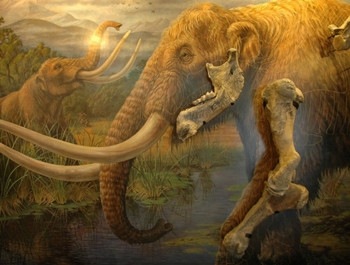
Some of this ice age dung was found beneath the skull in the Aucilla. The dung contained plant remains that tell us what the mastodon was browsing on 13,000 years ago or more—a mixture of trees and grasses.
在奧西拉市發現的頭骨下面發現了一些從冰河時代遺留下來的糞便。糞便中包含著植物化石,這告訴我們,在13000多年前,乳齒象的食物便是樹木和草的混合物。
This suggests that ice age Florida was drier than it is today—a mix of woodlands and savanna rather than swamps. And mastodon teeth found in the Aucilla held a more important revelation. The enamel contains chemical signatures of a local soil, passed by the plants the mastodons ate. But some of the chemicals found in the Aucilla teeth could only have come from soil hundreds of miles further north. The inescapable conclusion is that these mastodons migrated, making a round trip of more than 400 miles every year. And since their dung also contains remains of summer fruits from the Aucilla region, they must have travelled north for the winter.
這能夠告訴我們,冰河時代的佛羅里達比現在更加干燥,到處都是樹林和草原而不是沼澤。在奧西拉發現的乳齒象的牙齒透漏出了更多的重要信息。通過他們所吃的食物,牙齒上的釉質帶有一些當地土壤的化學成分。但是,一些牙齒上的化學成分都來于北方幾百英里外的土壤。我們很輕易地得出一個結論:這些乳齒象每年都進行400多英里的往返遷移。由于這些糞便中含有來自奧西拉地區的夏季水果化石,因此他們一定是在冬天向北方遷徙。
The question is, why? Why leave a place which as we have seen was abundant with food and a refuge from the cold? And why go north for the winter when most migrants move south? Perhaps the present climate can provide a clue.
問題是,這是為什么呢?為什么離開一個在我們看來食物充足并能抵御嚴寒的地方?為什么當大部分的動物向南部遷徙過冬時他們卻向北部遷徙?也許現在的氣候可以為我們提供一些線索。
Florida has a peculiar seasonal quirk. Although the winter months are cooler, they are also drier, much drier. Between October and February, there's almost no rainfall at all.
佛羅里達的氣候十分特殊。盡管冬季的月份更加寒冷,但是同樣也更加干燥,尤為干燥。在十月和二月之間,佛羅里達基本上沒有降雨。
英文文本來自普特英語,譯文屬可可原創,僅供學習交流使用,未經許可不得轉載。











